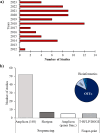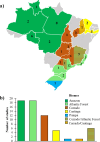The impact of land-use changes and management intensification on bacterial communities in the last decade: a review
- PMID: 38874336
- PMCID: PMC11267915
- DOI: 10.1128/aem.00309-24
The impact of land-use changes and management intensification on bacterial communities in the last decade: a review
Abstract
In the last decade, advances in soil bacterial ecology have contributed to increasing agricultural production. Brazil is the world leading agriculture producer and leading soil biodiversity reservoir. Meanwhile, there is still a significant gap in the knowledge regarding the soil microscopic life and its interactions with agricultural practices, and the replacement of natural vegetation by agroecosystems is yet to be unfolded. Through high throughput DNA sequencing, scientists are now exploring the complexity of soil bacterial communities and their relationship with soil and environmental characteristics. This study aimed to investigate the progress of bacterial ecology studies in Brazil over the last 10 years, seeking to understand the effect of the conversion of natural vegetation in agricultural systems on the diversity and structure of the soil microbial communities. We conducted a systematic search for scientific publication databases. Our systematic search has matched 62 scientific articles from three different databases. Most of the studies were placed in southeastern and northern Brazil, with no records of studies about microbial ecology in 17 out of 27 Brazilian states. Out of the 26 studies that examined the effects of replacing natural vegetation with agroecosystems, most authors concluded that changes in soil pH and vegetation cover replacement were the primary drivers of shifts in microbial communities. Understanding the ecology of the bacteria inhabiting Brazilian soils in agroecosystems is paramount for developing more efficient soil management strategies and cleaner agricultural technologies.
Keywords: Brazilian biomes; land-use change; soil bacterial communities; soil microbial ecology; tropical diversity.
Conflict of interest statement
The authors declare no conflict of interest.
Figures




Similar articles
-
Changes in diversity, abundance, and structure of soil bacterial communities in Brazilian Savanna under different land use systems.Microb Ecol. 2013 Oct;66(3):593-607. doi: 10.1007/s00248-013-0235-y. Epub 2013 Apr 27. Microb Ecol. 2013. PMID: 23624541
-
Temporal Dynamics of Bacterial Communities along a Gradient of Disturbance in a U.S. Southern Plains Agroecosystem.mBio. 2022 Jun 28;13(3):e0382921. doi: 10.1128/mbio.03829-21. Epub 2022 Apr 14. mBio. 2022. PMID: 35420482 Free PMC article.
-
Urban land uses shape soil microbial abundance and diversity.Sci Total Environ. 2023 Jul 20;883:163455. doi: 10.1016/j.scitotenv.2023.163455. Epub 2023 Apr 14. Sci Total Environ. 2023. PMID: 37062324
-
[Urban soils and microbial biodiversity].Med Sci (Paris). 2024 Nov;40(11):858-863. doi: 10.1051/medsci/2024147. Epub 2024 Dec 10. Med Sci (Paris). 2024. PMID: 39656983 Review. French.
-
Perspectives on the future of ecology, evolution, and biodiversity from the Council on Microbial Sciences of the American Society for Microbiology.mSphere. 2024 Nov 21;9(11):e0030724. doi: 10.1128/msphere.00307-24. Epub 2024 Oct 10. mSphere. 2024. PMID: 39387587 Free PMC article. Review.
References
-
- Overbeck GE, Vélez-Martin E, Menezes L da S, Anand M, Baeza S, Carlucci MB, Dechoum MS, Durigan G, Fidelis A, Guido A, et al. . 2022. Placing Brazil’s grasslands and savannas on the map of science and conservation. Perspect Plant Ecol Evol Syst 56:125687. doi:10.1016/j.ppees.2022.125687 - DOI
-
- Mendes LW, de Lima Brossi MJ, Kuramae EE, Tsai SM. 2015. Land-use system shapes soil bacterial communities in Southeastern Amazon region. Appl Soil Ecol 95:151–160. doi:10.1016/j.apsoil.2015.06.005 - DOI
-
- Neyret M, Fischer M, AllanE E, Hölzel N, Klaus V, Kleinebecker T, Krauss J, Le Provost G, Peter S, Schenk N, Simons N, Van der Plas F, Binkenstein J, Börshig C, Jung K, Prati D, Schäfer M, Schäfer D, Schöning I, Schrumpf M, Tschapk M, Westphal C, Manning P. 2021. Landscape management for grassland multifunctionality. bioRxiv. doi:10.1101/2020.07.17.208199 - DOI
Publication types
MeSH terms
Substances
Grants and funding
LinkOut - more resources
Full Text Sources
Miscellaneous

